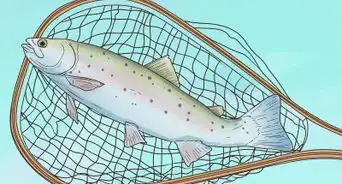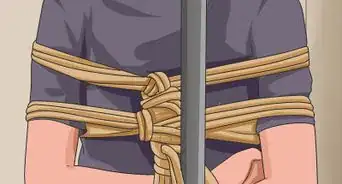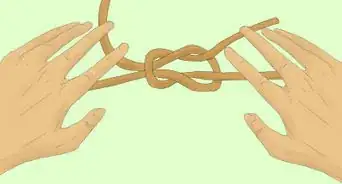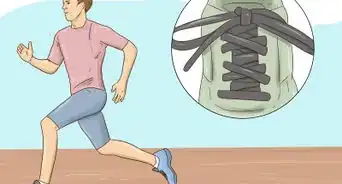This article was co-authored by wikiHow Staff. Our trained team of editors and researchers validate articles for accuracy and comprehensiveness. wikiHow's Content Management Team carefully monitors the work from our editorial staff to ensure that each article is backed by trusted research and meets our high quality standards.
There are 7 references cited in this article, which can be found at the bottom of the page.
This article has been viewed 226,463 times.
Learn more...
A Palomar knot, used for securing fishing line to fishing hooks, is a study and reliable knotting technique. Palomar knots can also be used on both braided fishing line and thin, monofilament fishing line, which makes them versatile. When done correctly, this easy to tie knot is considered one of the most dependable variations of fishing knots to exist.
Steps
Threading The Line
-
1Thread the line through the hook eye. Hold the fishing hook vertical with your thumb and pointer finger. Poke the fishing line through the eye of the hook, and pull about 12 inches of line through.[1]
-
2Thread the line back through the hook eye. With the tag line pulled through the eye of the hook, poke the fishing line back through the hook eye. Leave room for about 6 inches of line on both sides of the hook eye; the tag end of the line and the looped end through the hook eye. This will ensure that you have enough line to make your overhand knot and pass the hook completely through the loop.
- Try not to pinch the line and push it through the hook eye. If you’re working with very fine line, pinching it will create a kink that can cause a break in your line later when you’re fishing.[2]
- Make sure that the tag line and reel line are not crossed over each other or twisted before you tie the overhand knot.[3]
Knotting The Line
-
1Make an overhand knot. With both doubled up lines, make a simple overhand knot. Cross the looped line over the tag line and line leading back to the fishing reel. Turn the looped line underneath the tag and reel lines, and loosely pull it. Make sure that the hook is hanging at the bottom of the loose knot.[4] Leave enough space in the looped section of the line so the hook can later fit through the center of the loop.[5]
-
2Drop the hook through the loop. Hold the overhand knot with your thumb and pointer finger, and place the finishing hook though the looped end of the line.[6] Gently pull all the lines back to make sure nothing is caught on the hook or around the sometimes rough area of the bottom of the hook eye.[7]
-
3Pull the knot tight. Use your mouth and tongue to lubricate the line and the knotted area near the hook eye.[8] Hold onto the hook with one hand and let go of the looped line. Pull the main line and the tag line simultaneously with your other hand to secure the knot.
-
4Clip the tag line. Separate the tag line and the line going back to the reel, and pull them in opposite directions to make sure the knot is tied tight. Use scissors to trim off the excess end of the hanging tag line. Leave a centimeter or two of leftover tag line.
Community Q&A
-
QuestionWhy do Palomar knots fail?
 wikiHow Staff EditorThis answer was written by one of our trained team of researchers who validated it for accuracy and comprehensiveness.
wikiHow Staff EditorThis answer was written by one of our trained team of researchers who validated it for accuracy and comprehensiveness.
Staff Answer wikiHow Staff EditorStaff AnswerA Palomar knot may fail if you kink the line or cross the lines while tying the knot. If you’re using a fluorocarbon line, you’ll also need to use line lubricant to prevent friction, which can cause the line to overheat and fail.
wikiHow Staff EditorStaff AnswerA Palomar knot may fail if you kink the line or cross the lines while tying the knot. If you’re using a fluorocarbon line, you’ll also need to use line lubricant to prevent friction, which can cause the line to overheat and fail. -
QuestionWhich is stronger, the Palomar knot or the uni knot?
 wikiHow Staff EditorThis answer was written by one of our trained team of researchers who validated it for accuracy and comprehensiveness.
wikiHow Staff EditorThis answer was written by one of our trained team of researchers who validated it for accuracy and comprehensiveness.
Staff Answer wikiHow Staff EditorStaff AnswerThe uni knot is a bit stronger than the Palomar knot, but the Palomar knot is a little faster and easier to tie.
wikiHow Staff EditorStaff AnswerThe uni knot is a bit stronger than the Palomar knot, but the Palomar knot is a little faster and easier to tie. -
QuestionHow many pounds can a Palomar knot hold?
 wikiHow Staff EditorThis answer was written by one of our trained team of researchers who validated it for accuracy and comprehensiveness.
wikiHow Staff EditorThis answer was written by one of our trained team of researchers who validated it for accuracy and comprehensiveness.
Staff Answer wikiHow Staff EditorStaff AnswerA well-tied Palomar knot on mono can hold about 30 pounds. Palomar knots on braid aren’t as strong, and will only hold about 15 pounds.
wikiHow Staff EditorStaff AnswerA well-tied Palomar knot on mono can hold about 30 pounds. Palomar knots on braid aren’t as strong, and will only hold about 15 pounds.
Warnings
- Take precautions and be careful when handling the sharp fishing hook.⧼thumbs_response⧽
References
- ↑ https://www.youtube.com/watch?v=UNBCkPZg5gw
- ↑ https://www.youtube.com/watch?v=UNBCkPZg5gw
- ↑ http://www.scout.com/outdoors/wired2fish/story/1468388-how-to-tie-the-palomar-knot
- ↑ http://www.netknots.com/fishing_knots/palomar-knot/
- ↑ https://www.youtube.com/watch?v=UNBCkPZg5gw
- ↑ http://www.netknots.com/fishing_knots/palomar-knot/
- ↑ https://www.youtube.com/watch?v=UNBCkPZg5gw
- ↑ https://www.youtube.com/watch?v=DhQA8dP9b9E
- ↑ http://www.scout.com/outdoors/wired2fish/story/1468388-how-to-tie-the-palomar-knot
About This Article
To tie a Palomar knot, start by holding a fish hook vertically with your thumb and pointer finger, threading some line through the eye, and pulling 12 inches of line through. Next, thread the line back through the eye and leave room for 6 inches on both sides. After that, make an overhand knot by crossing the looped line over the tag line and the line leading back to the reel. Then, turn the looped line under the tag and reel line and loosely pull. Finally, drop the hook through the loop, pull the knot tight, and clip the tag line. For more tips, like how to make threading the line easier, read on!





















































